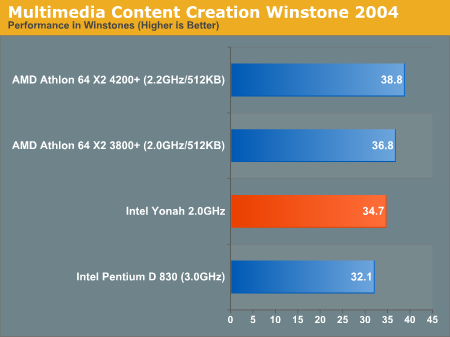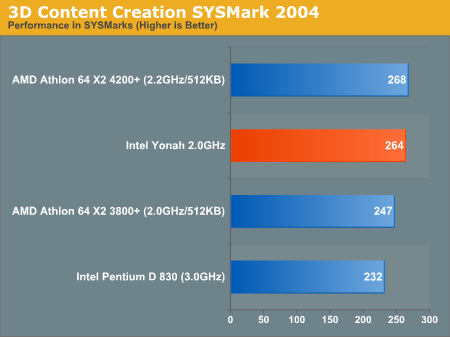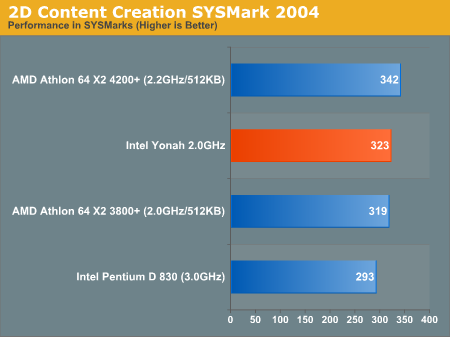Intel Yonah Performance Preview - Part I: The Exclusive First Look at Yonah
by Anand Lal Shimpi on November 30, 2005 2:50 AM EST- Posted in
- CPUs
Multitasking Content Creation
MCC Winstone 2004
Multimedia Content Creation Winstone 2004 tests the following applications in various usage scenarios:
. Adobe® Photoshop® 7.0.1
. Adobe® Premiere® 6.50
. Macromedia® Director MX 9.0
. Macromedia® Dreamweaver MX 6.1
. Microsoft® Windows MediaTM Encoder 9 Version 9.00.00.2980
. NewTek's LightWave® 3D 7.5b
. SteinbergTM WaveLabTM 4.0f
All chips were tested with Lightwave set to spawn 4 threads.

While the 2.0GHz Yonah processor is faster than the Pentium D, the X2 3800+ manages to hold a marginal 6% lead over Intel's newcomer. This is somewhat of a disappointment, given the enhancements Yonah has that are specifically designed to improve performance in situations like this. While Yonah is doing better than Dothan here, it's not good enough to beat AMD.
ICC SYSMark 2004
The first category that we will deal with is 3D Content Creation. The tests that make up this benchmark are described below:
"The user renders a 3D model to a bitmap using 3ds max 5.1, while preparing web pages in Dreamweaver MX. Then the user renders a 3D animation in a vector graphics format."

The situation changes dramatically when we look at SYSMark's ICC performance, here the 2.0GHz Yonah is right on the heels of AMD's Athlon 64 X2 4200+, maintaining just under a 7% lead over the identically clocked X2 3800+.
Next, we have 2D Content Creation performance:
"The user uses Premiere 6.5 to create a movie from several raw input movie cuts and sound cuts and starts exporting it. While waiting on this operation, the user imports the rendered image into Photoshop 7.01, modifies it and saves the results. Once the movie is assembled, the user edits it and creates special effects using After Effects 5.5."

Yonah continues to fall in between the X2 3800+ and the 4200+, this time being much closer to the former.
The Internet Content Creation suite is rounded up with a Web Publishing performance test:
"The user extracts content from an archive using WinZip 8.1. Meanwhile, he uses Flash MX to open the exported 3D vector graphics file. He modifies it by including other pictures and optimizes it for faster animation. The final movie with the special effects is then compressed using Windows Media Encoder 9 series in a format that can be broadcast over broadband Internet. The web site is given the final touches in Dreamweaver MX and the system is scanned by VirusScan 7.0."

Once more we see that Yonah isn't perfect, being outpaced by the X2 3800+ by around 8%. Of course power consumption matters, but we'll save that comparison for the end of this article :)










135 Comments
View All Comments
coldpower27 - Wednesday, November 30, 2005 - link
It doesn't seem that bad actually at 423US for 2.0GHZ Yonah at launch, it isn't double the 294US, that they are charging for Dothan 2.0GHZ parts now, the price isn't like the double we are seeing on Athlon 64x2.Furen - Wednesday, November 30, 2005 - link
Huh? I'm saying that the FX-60 will probably match the EE edition of Yonah, which (supposedly) will have a 50+ W TDP and will hardly be a "mid-range" mobile chip.coldpower27 - Wednesday, November 30, 2005 - link
These are the leaked pricing sheets from around the web on the launch pricing of Yonah.T2600/ Yonah 2.17GHZ/667/2MB 637US
T2500/ Yonah 2.00GHZ/667/2MB 423US
T2400/ Yonah 1.83GHZ/667/2MB 294US
T2300/ Yonah 1.67GHZ/667/2MB 241US
T means somewhere in 25W-49W TDP
Yonah Extreme Edition would be interesting, either 2.5GHZ/2.66GHZ if on the same FSB speed.
Furen - Wednesday, November 30, 2005 - link
It would have been nice if you'd included Dothan's power consumption just to see whether or not the "Yonah will have a 49W TDP" claims have any validity. I dont suppose you guys are up to testing the current CPU's current draw directly, huh? :)coldpower27 - Wednesday, November 30, 2005 - link
Also you got to keep in mind Yonah will fall in the T category, of processors which is 25W-49W in TDP, with the way Intel measures it. The acutal TDP of Yonah was supposed to be 31W.Furen - Wednesday, November 30, 2005 - link
Yes, but when Intel announced that Yonah was going to fall into that category EVERYONE (most tech sites, heck, even Cnet) equated that to a higher TDP Yonah, which is why it would have been nice to have something to compare it against.bob661 - Wednesday, November 30, 2005 - link
Anandtech is NOT measuring TDP in these tests!!!!!! They ARE measuring what they call "Total Power Consumption". These are two TOTALLY different measurements. AT can only measure power consumed by the ENTIRE computer coming from the wall socket. They can't measure TDP in these tests. It's not the same. It's not the same. Jesus!Furen - Sunday, December 11, 2005 - link
I never said they could measure TDP. I asked if they were willing to measure the CPU's current draw directly, which is VERY doable, though it takes a bit more effort. If you remember that a month or so ago there were news articles published at, basically, all tech news sites claiming that Yonah would have a greater TDP than it was originally anticipated. Though TDP is not necessarily the typical power draw, a higher TDP (compared to another one that is defined the same way) can lead to a higher current draw.I said that it'd be nice if they could include dothan in order to have a CPU with which to do an apples to apples comparison. Try to keep your patronizing comments to yourself if you don't plan on at least reading what you're commenting on properly.
Calin - Friday, December 2, 2005 - link
Nobody can measure the TDP - TDP is the Total Designed Power - and refer mostly to the cooling capacity of the processor package. You will see several models of processors having the same TDP even if their power consumption is certainly different.The Sempron 2500, 2600, 2700 and I think 2800 have the same TDP - even if the 2500 is a 256kB L2 cache part and the 2600 and 2800 have just 128kB L2 cache.
TDP is NOT power consumption!
Calin - Friday, December 2, 2005 - link
Sorry. TDP is thermal design power